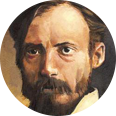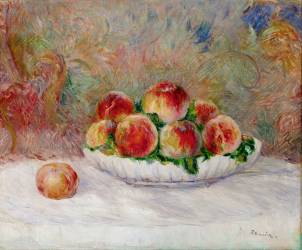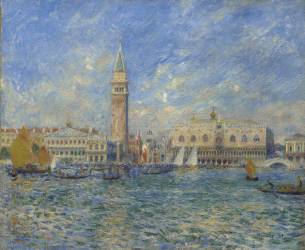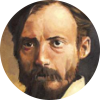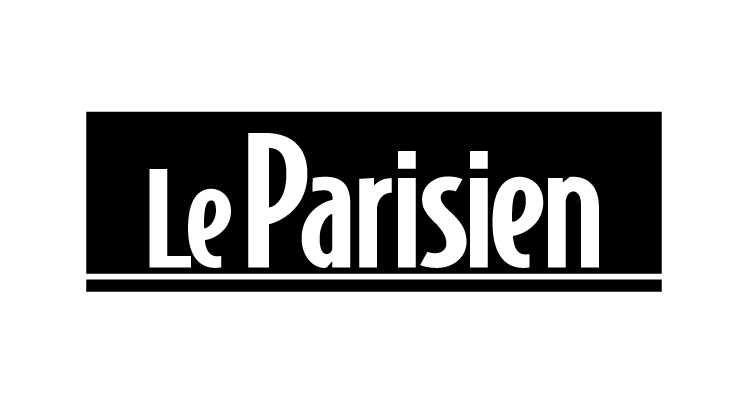Artwork of Auguste Renoir canvas prints & artprints
A precursor of Impressionist painting, Auguste Renoir was undoubtedly one of the most prolific painters of the second half of the 19th century and the early 20th century. In a style all his own, he drew his inspiration from the finest canvases of academic painting to create a technique somewhere between Impressionism and the Classicism of the time, depicting the joyous moments in the lives of colourful characters.
Discover some of Auguste Renoir's finest paintings, including "Bal du Moulin de la Galette", representative of his Impressionist period, "Le déjeuner des canotiers", one of his most famous canvases to date, and "Jeunes filles au piano", a key work from the artist's "pearly" period.
Treat yourself to a reproduction from the catalogue of Auguste Renoir, one of the greatest French painters in the history of art, and find out more about his biography.
Biography of Auguste Renoir
Youth and training
Pierre Auguste Renoir was born in Limoges on 25 February 1841 into a family of artisans of modest means. The Renoir family soon moved to Paris, where young Auguste grew up before being taken on as an apprentice at the age of 13 in the porcelain workshop of Lévy Frères & Compagnie, where he produced decorations as a painter on porcelain. It was also during this period that he trained in decorative arts drawing, and took various artistic courses such as music lessons. After some decorative art work for his brother Henri, Auguste Renoir entered the Ecole des Beaux-Arts in Paris in 1862, at the age of 21, to further his training as a painter. It was during his 2 years at the Beaux-Arts academy that he met the painters Claude Monet, Alfred Sisley and Frédéric Bazille, with whom he forged strong ties that would later lead to the development of the Impressionist movement. In the meantime, far from the Impressionist painting to come, Renoir remained rooted in a pictorial tradition close to academic painting, drawing inspiration from Classicism, Realism, Romanticism and Orientalism, influenced by the canvases of the Romantic and academic painters Delacroix, Ingres and Gustave Courbet. He even took part in the Salon of 1865, with a portrait of William Sisley, the father of his friend Alfred Sisley. Although not much appreciated by professionals, the young art critic Émile Zola saw in the painter's paintings a real talent just waiting to be followed.
Auguste Renoir: a precursor of the Impressionist movement
It was in 1869 that Renoir, accompanied by his painter friend Monet, set up his easel at La Grenouillère, a bathing establishment where Parisian canoeists met. This period had a strong influence on both Monet's and Renoir's painting, as the young painters fully captured the effects of light by painting in the open air. Their brushstrokes were also to evolve, with quick brushstrokes and the use of light colours, characteristic of what was to become the Impressionist movement. While Monet painted landscapes, Renoir moved away from landscape painters to focus on the people who populated this green space a stone's throw from Paris. Following the war between France and Prussia, which put a stop to Renoir's career, the Impressionist painter took part in the first exhibition of Impressionist painters, held on the fringes of the official Salon, which was too conservative for his contemporaries. In addition to Pierre Auguste Renoir, his friend Claude Monet and the avant-garde Impressionist painters Paul Cézanne, Camille Pissarro and Edgar Degas were also there, presenting this innovative pictorial movement to the public alongside artists representing academic art, so that the Salon would not be seen as another Salon des refusés. It was at the third Impressionist Salon in 1877 that Auguste Renoir presented his oil on canvas "Le bal du moulin de la galette", and in 1882, at the seventh Impressionist Salon, he presented "Le Déjeuner des canotiers", one of the most famous Impressionist paintings along with Monet's "Impression soleil levant". This emblematic canvas, showing people in action, including his partner Aline Charigot, also heralded the end of the Impressionist style for Renoir.
A radical change of style for Auguste Renoir
It was in the early 1880s that Renoir, ruined by the lack of interest in Impressionist canvases, and thinking he had reached the end of his road, decided to turn a page in his life and distance himself from this artistic movement and the painters who were the precursors of Post-Impressionism, such as Vincent Van Gogh and Paul Cézanne, to concentrate on a pictorial style closer to academicism. We can see the evolution of his art, with realistic compositions such as "Danse à la ville" and "Danse à la campagne" (now on show at the Musée d'Orsay), which, although the theme still revolves around scenes of everyday life, as in his Impressionist paintings of the 1870s, see the outlines of the figures become more pronounced, and the flat tones of colour more present. He reached the height of this change of style with his Ingresque period, and his painting "Les grandes baigneuses", in a technique reminiscent of that of Jean-Auguste-Dominique Ingres and Raphael. But it was in the 1890s that Auguste Renoir began to acquire a certain notoriety among collectors with his "pearly" period. By painting portraits and scenes from bourgeois circles, and focusing on women and young girls, as in "Jeunes filles au piano", he succeeded in mastering his art by bringing together the academic and Impressionist styles, in compositions that were somewhere between realist and Impressionist painting. He also drew inspiration from the maternity of his wife Aline, Renoir having become the father of three sons between 1885 and 1901, and illustrated his children on several occasions, as in the painting "Gabrielle et Jean enfant". From his studio in Essoyes, the painter's works became unavoidable in France, making Renoir one of the great painters of the late 19th and early 20th centuries.
End of life: Auguste Renoir, a major figure in 19th and 20th century painting
With his mastery of transparent oils, the painter's name crossed borders, and his canvases reached Europe and even the United States. The art dealer and collector Paul Durand-Ruel, a member of the Parisian bourgeoisie and a fervent promoter of Impressionism, was one of Renoir's strongest supporters, distributing the French painter's works through his network of art galleries, from Paris to New York, via London and Brussels. During this period, Renoir was even nominated for the Légion d'honneur, which he initially refused, but later accepted. After settling with his wife Aline and children in Cagnes-sur-Mer, where the climate was more favourable for his rheumatoid arthritis, which caused him to suffer increasingly from painful rheumatism, the painter distinguished himself by specialising in nudes, portraits and still lifes. He also tried his hand at designing sculptures with his friends Richard Guino and Louis Morel in 1913. Despite the pain, Renoir continued to paint until his death in 1919 at the age of 78.
The artistic legacy of Auguste Renoir
Initially considered to be the precursor of Impressionism along with a whole group of artists from the late 19th century, such as Monet, Cézanne and Pissarro, Renoir nonetheless managed to reinvent himself by testing out several pictorial movements, including Ingresque academicism, and then working on his own style, situating it between the official art of the time and French Impressionist painting. Whatever his period, Renoir's work always focused on people rather than landscapes, depicting the joyful scenes of everyday life in his canvases, both indoors in his salons and workshops, and outdoors with his depictions of the banks of the Seine, among others. Women were also a real source of inspiration for Pierre Auguste Renoir, with his paintings of nudes and his works on motherhood, which punctuated part of his work. Today, Renoir is regarded as one of France's most prolific painters, having produced over 4,000 canvases in his career. A collection of his works can be found all over the world, in France at the Musée d'Orsay, the Musée de l'Orangerie (the Musée d'Orsay and the Musée de l'Orangerie have one of the largest collections of the artist's work), the Musée Marmottan Monet and the Musée du Louvre, as well as abroad at the Museum of Fine Arts in Boston, as well as the National Gallery in London and the Hermitage Museum in St Petersburg, among others.
Learn more about the life and the works of Auguste Renoir.


